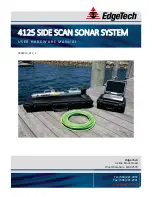
ACTIVE SONAR USAGE
SeaBat 7125 SV2 Operator‟s Manual
Page 110
July 25, 2011
Version 3
6.6 Compensation for Environmental Conditions
As sound propagates through the underwater environment, the energy is absorbed by
the liquid caused by molecular interactions that convert acoustic energy into heat. A
propagating sound field also spreads geometrically, which means that the sound
pressure decreases with increasing distance from the sonar. Other mechanisms such as
bubbles, plankton, tidal currents, currents from rivers etc. may influence sound
propagation, but these mechanisms are difficult to measure and model, as they vary with
time and only appear in a limited number of areas. However, as absorption and
geometrical spreading exist everywhere in the underwater environment, they are
considered to be the most important loss mechanisms.
In the SeaBat system it is possible to compensate for loss caused by absorption and
geometrical spreading. In addition, the SeaBat system allows for changes in the speed
of sound, a parameter which is important in the beamforming process.
For instructions on how to adjust these settings, see
section 5.7.3 Ocean Settings
6.6.1 Loss of Sound by Absorption
The amount of loss of sound through absorption in water depends on the water
conditions and the sound frequency. As sound moves through the water, the water
absorbs it by converting some of the acoustic energy to heat. The absorption loss is
proportional with the salinity of the water and the sound frequency: the higher the salinity
or frequency, the greater the loss (see
). The figure
also shows that an
increased temperature will increase the absorption loss.
The absorption loss value is part of the formula that the SeaBat system uses to calculate
the amount of gain to apply to the sonar return signal (see
section 6.2.4 above
If the exact absorption loss value is not known, a value of 110dB/km for salt water and
70dB/km for fresh water is recommended for 400kHz operation, and a value of 50dB/km
for salt water and 20dB/km for fresh water is recommended for 200kHz operation. For
instructions on how to adjust this setting, see
section 5.7.3.1 Change the Absorption
provides a general reference for acoustic absorption at different frequencies
and salinity in three different temperature environments.
Summary of Contents for SeaBat 7125 SV2
Page 2: ...This page intentionally left blank...
Page 211: ......































